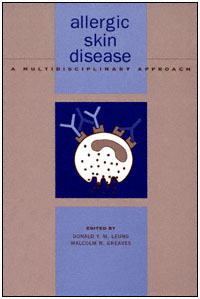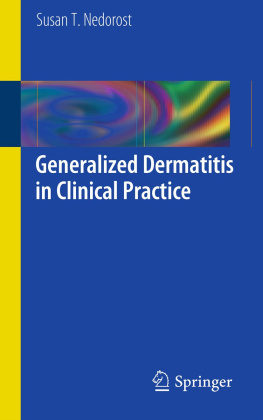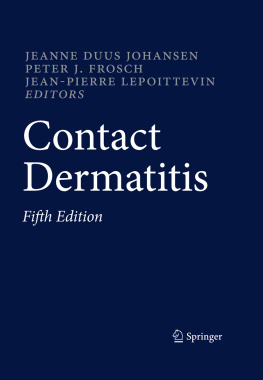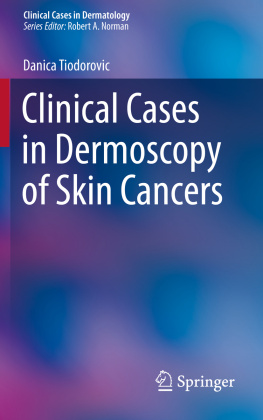Cover

| title | : | Allergic Skin Disease : A Multidisciplinary Approach |
| author | : | Leung, Donald Y. M. |
| publisher | : | Informa Healthcare |
| isbn10 | asin | : | 0824702875 |
| print isbn13 | : | 9780824702878 |
| ebook isbn13 | : | 9780585377322 |
| language | : | English |
| subject | Dermatitis, Allergic Contact, Dermatitis, Atopic, Skin Diseases, Allergy, Skin--Diseases. |
| publication date | : | 2000 |
| lcc | : | RC592.A45 2000eb |
| ddc | : | 616 |
| subject | : | Dermatitis, Allergic Contact, Dermatitis, Atopic, Skin Diseases, Allergy, Skin--Diseases. |
Page a
allergic
skin
disease
Page i
allergic skin disease
A MULTIDISCIPLINARY APPROACH
EDITED BY
DONALD Y. M. LEUNG
National Jewish Center for Immunology
and Respiratory Medicine
Denver, Colorado
MALCOLM W. GREAVES
United Medical and Dental School of
Guys and St. Thomass Hospitals
Kings College
London, England

Page ii
ISBN: 0-8247-0287-5
This book is printed on acid-free paper.
Headquarters
Marcel Dekker, Inc.
270 Madison Avenue, New York, NY 10016
tel: 212-696-9000; fax: 212-685-4540
Eastern Hemisphere Distribution
Marcel Dekker AG
Hutgasse 4, Postfach 812, CH-4001 Basel, Switzerland
tel: 41-61-261-8482; fax: 41-61-261-8896
World Wide Web
http://www.dekker.com
The publisher offers discounts on this book when ordered in bulk quantities. For more information, write to Special Sales/Professional Marketing at the headquarters address above.
Copyright 2000 by Marcel Dekker, Inc. All Rights Reserved.
Neither this book nor any part may be reproduced or transmitted in any form or by any means, electronic or mechanical, including photocopying, microfilming, and recording, or by any information storage and retrieval system, without permission in writing from the publisher.
Current printing (last digit):
10 9 8 7 6 5 4 3 2 1
PRINTED IN THE UNITED STATES OF AMERICA
Page iii
Preface
Allergic skin diseasesparticularly atopic dermatitis, urticaria, and contact dermatitisare extremely common, affecting over 20% of the general population at some point during their lifetime. Population studies since World War II have documented a continuous rise in the prevalence of allergic skin diseases. In those patients afflicted with these skin disorders, involvement can be lifelong, causing significant interference with education, occupations, and overall quality of life. The economic impact of allergic skin diseases is also enormous, with atopic hand dermatitis representing a major cause of occupation-related disability.
In recent years, there has been an explosion of knowledge concerning immune responses in the skin and their role in the pathogenesis of allergic skin diseases. Key cell types, effector molecules, cytokines, mediators, chemokines, cell adhesion molecules, and immunogenetic mechanisms that determine the final clinical phenotype of various allergic skin disorders are rapidly being delineated. These advances have led to new paradigms for the mechanisms of these skin disorders and the development of new approaches to their management.
Allergic Skin Diseases is aimed at updating the reader on the pathophysiology of allergic skin responses, the mechanisms underlying specific allergic skin diseases, their socioeconomic impact, and new treatment approaches that take advantage of emerging concepts of the pathobiology of these diseases. An outstanding group of allergists, immunologists, and dermatologists, who are acknowledged leaders in their fields, has been assembled in this book to discuss this important and rapidly changing area of medicine. Every effort has been made to achieve prompt publication of this book, thus ensuring that the content of each chapter is state of the art. Part One presents general principles critical to an understanding of the impact and causes of allergic skin diseases. These include a discussion of epidemiology and socioeconomic impact, quality-of-life issues, molecular and cellular mechanisms of skin responses, the role of adhesion molecules, and the pathophysiology of pruritus. Part Two examines the clinical features and pathophysiology of specific allergic skin diseases, emphasizing the role of immune mechanisms in accounting for the clinical course of each illness. Part Three underpins the clinical relevance of understanding mechanisms of allergic skin diseases in the context of their differential diagnoses, evaluations, environmental triggers, and concepts of emerging and established treatments.
Page iv
We would like to thank each of the contributors for their time and invaluable expertise, which were vital to the success of this book. We hope that this new text will provide a valuable resource for dermatologists, allergists, internists, pediatricians, basic and clinical immunologists; and graduate students interested in the immunological basis and treatment of allergic skin diseases.
Donald Y. M. Leung
Malcolm W. Greaves
Page v
Contents
| Preface | iii |
| Contributors | vii |
| PART ONE: GENERAL PRINCIPLES |
1. Epidemiology and Socioeconomic Impact of Allergic Skin Diseases
Finn Schultz Larsen | 1 |
2. Economic Evaluations in Allergic Skin Diseases
Rukmini Rajagopalan | 21 |
3. Molecular Mechanisms of Allergic Skin Responses
Robert C. Fuhlbrigge and Thomas S. Kupper | 29 |
4. Cellular Mechanisms of Allergic Skin Responses
Kefei Kang, Seth R. Stevens, and Kevin D. Cooper | 53 |
5. Adhesion Molecules and Their Role in Allergic Skin Diseases
Bruce S. Bochner and Lisa A. Beck | 87 |
6. Pathophysiology of Pruritus
Malcolm W. Greaves | 113 |
| PART TWO: SPECIFIC ALLERGIC SKIN DISEASES |
7. Atopic Dermatitis
Mark Boguniewicz and Donald Y. M. Leung | 125 |
8. Urticaria and Angioedema
Malcolm W. Greaves | 171 |
9. The Physical Urticarias
E. Frances Lawlor | 195 |
10. Immunology of Allergic Contact Dermatitis
John Mcfadden | 213 |
11. Chronic Actinic Dermatitis
Hlne Du Peloux Menag and John L. M. Hawk | 223 |
Page vi
12. Latex Allergy
James S. Taylor, Penpun Wattanakrai, B. Lauren Charous, and Dennis Ownby | 237 |
13. Reactions to Stinging and Biting Insects
Pamela W. Ewan | 271 |
14. Cutaneous Vasculitis
Nicholas A. Soter | 291 |
15. Drug-Induced Cutaneous Reactions
Rebecca S. Gruchalla and Vincent S. Beltrani |
Next page










